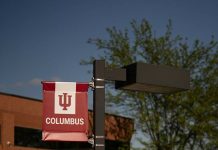Workers will have to rip up and replace asphalt at the approaches of the new Newbern Bridge just five months after it opened.
That determination was made after the pavement failed a quality assurance test that specifies and measures the density in hot mix asphalt pavements and overlays, said Harry Maginity, spokesman for the Indiana Department of Transportation.
Luckily for nearby residents along Huffer and Newbern roads in eastern Bartholomew County, as well as County Road 265N, they won’t have to face long detours like they did for most of 2015.
It’s likely that one lane of traffic will be maintained along County Road 850E while work on approaches to the bridge is being done, Maginity said.
There is no evidence that there was anything wrong with the asphalt mix, such as not having enough prime or aggregate in the mix, Maginity said.
“It looks like compression and compaction are the problems,” Maginity said.
The INDOT spokesman emphasized that while there is an asphalt problem, “the bridge itself is great.”
Although it’s a county bridge, the state maintains jurisdiction on construction-related issues because most of last year’s work was financed with federal funds administered through the state, Bartholomew County Highway engineer Danny Hollander said.
While the bridge contract was awarded to Force Construction of Columbus, company president Harold Force said the paving was subcontracted out to Dave O’Mara Contractor Inc. of North Vernon.
Although officials at O’Mara are now looking into the concerns expressed by INDOT, that doesn’t necessarily mean the North Vernon company has agreed to redo its work at its own expense, Force said.
“My guess is that (O’Mara) will pursue an appeal,” Force said. “Similar tests on other parts of the pavement may yield different results.”
Until the anticipated challenge with INDOT is resolved, state highway officials are unable to set a timeline for when the milling and grinding project will begin or end, Maginity said.
Failures during asphalt density tests are common, and since only the top layer of blacktop needs to be redone, the work should not “be any big deal” in terms of the amount of time it will take, Maginity said.
But what is unusual is the extensive amount of delays, problems and unexpected expenses encountered with replacing the Newbern Bridge since the project was initially approved in 1999.
For example, it’s been 15 years since more than $100,000 in local tax money was spent to excavate the area as well as remove and document more than 350 artifacts.
Then the state announced three years ago it would pull a 2004 grant that would pay for rehabilitating the old historic Newbern Bridge and relocating it a few blocks south of Eastbrook Plaza in Columbus.
Due to extensive local lobbying, that funding was reinstated 14 months after it was withdrawn.
The historic structure, now being stored in Lincoln Park, is scheduled to be moved into place over Haw Creek as part of the People Trail system this fall, with all work completed sometime next year.
But even after the new Newbern bridge opened in mid-September, the county still had to approve seven change orders that collectively have added another $87,820 to the original $1.4 million cost.
The most expensive was the result of unexpected topography discovered on either side of the bridge that required longer pile drivers and rock excavations for adequate foundation support.
“Hopefully, that string of challenges will soon be broken,” Force said. “The Newbern bridge has been a successful job, and we enjoyed it.”




